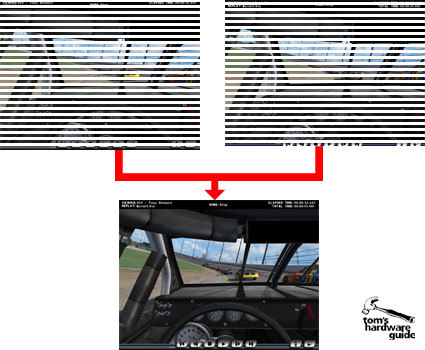NVIDIA Takes a Walk on the SLI Side with Double Graphics Processing
Requirements For Double Graphics Processing
If you want to use two graphics cards in parallel for 3D calculations, you first need to overcome some technical difficulties. First, the render information needs to be divided between the two cards. Next, you'll need a method of getting the image information that is rendered on the second card to the card actually connected to the monitor. Finally, the two parts of the image need to be merged for display on the monitor.
Back in the days of the Voodoo 2 add-on cards, SLI was a very complex matter, as you needed a "normal" 2D graphics card for non-3D applications in addition to the two Voodoo 2 cards. The VGA signals of this 2D card were transferred to the Voodoo 2 cards using an external cable, while the synchronization of the two Voodoo 2 cards and the exchange of image information occurred using a ribbon cable. The graphics information was split so that one card would render only the odd lines of the scene, while the other one took care of the even ones. Later, the results were merged or interleaved, hence the name "scan line interleaving."
SLI the Voodoo2 way. Card one renders the even lines, card two the odd ones. The result is merged together.
Alienware uses a special driver for its proprietary graphics array. It splits the image along the middle horizontally and then assigns one card the top half and the other card the bottom half for rendering. The VGA-connectors of each card are hooked up to an additional board that merges the signals and then outputs the final result to the monitor. Another possibility for exchanging data between the cards would be to use the PCI Express bus.
Get Tom's Hardware's best news and in-depth reviews, straight to your inbox.
Current page: Requirements For Double Graphics Processing
Prev Page Introduction Next Page NVIDIA SLI Multi-GPU